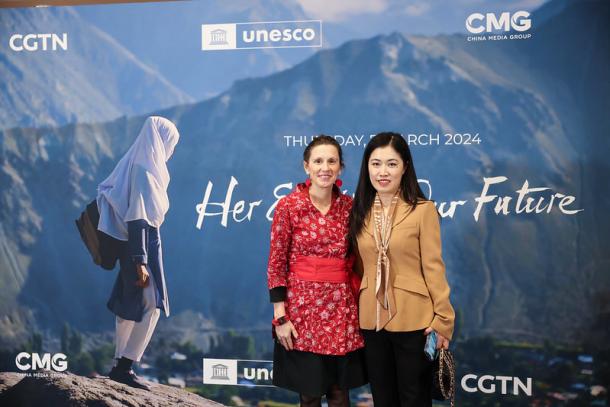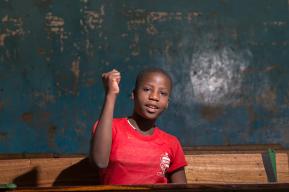News
30th Anniversary of the Salamanca Statement on inclusive education: 3 Questions to Justine Sass

Why was the Salamanca Statement such a milestone when it was adopted in 1994 and how relevant is it today and for the future generations?
The Salamanca Statement on Inclusion in Education was adopted in 1994 at the World Conference on Special Needs Education hosted by UNESCO and the Spanish Ministry of Education in Salamanca, Spain.
The Statement and its accompanying framework for action represent a worldwide consensus on future directions for the education of children with special needs. It is considered to have catalyzed inclusive education worldwide.
Since Salamanca, efforts for inclusive education have continued. The Sustainable Development Goals (SDGs) adopted in 2015 and specifically Goal 4 recognizes the urgent need to provide equitable and inclusive quality education for all, with a lifelong learning perspective. It calls on governments to step up efforts to achieve inclusion in education with special emphasis on the role of civil society and the involvement of marginalized groups.
It was further highlighted at the United Nations Transforming Education Summit (TES) in 2022, which recalled the foundation of the SDGs – to leave no one behind.
What are countries doing, and how is UNESCO supporting action?
The TES Dashboard of Country Commitments and Actions shows that of the 143 national commitments made by countries at the Summit, 87% recognized the importance of ensuring more inclusive education systems that cater for the needs of the most vulnerable learners and communities.
Many countries have enacted laws and policies to promote inclusive education and there has been a shift in attitudes towards inclusion in education. Educators, policymakers, parents and communities, are recognizing the value of education that promotes diversity, equity and social cohesion.
Around 60% of countries provide teacher training on inclusion, enabling them to foster inclusive classroom environments and collaborate with special education professionals and support staff.
At the global level, UNESCO supports the right to education of the most disadvantaged children and youth, largely through advocacy, monitoring and policy recommendations.
At the country level, UNESCO supports countries to operationalize evidence-based recommendations on inclusion. For example, UNESCO recently supported 9 Southern African countries to develop their systems thinking skills to expand inclusive education. In Asia and the Pacific, UNESCO has launched an online professional Equity and Inclusion in Education development course. In Jordan, UNESCO is supporting the Ministry of Education to develop a National Framework on Inclusion and Diversity in Education.
UNESCO promotes system-level change to ensure that all learners, regardless of their circumstances and personal characteristics, are able to benefit from and participate in education.
Inclusion values ‘difference’ as an asset but understands that it can require more thought, time and resources.

What could be a game changer in promoting inclusive schools?
To overcome inequality and injustice, we must widen the lens and act on all factors that marginalize children and youth and hijack their educational journey. Barriers to inclusion include: attitudes; physical access and learning environment; rigid curriculum; ways teachers are trained, language of instruction; socio-economic factors, lack of political will and funding. Record high levels of displaced people amplifies the risk of exclusion from education. We must approach these barriers holistically.
Inclusion calls for transformation – for a paradigm shift in the philosophy and practice of education. The question before us today is how to accelerate this transformation to make inclusion a reality.
First, governments must ensure that adequate legislative frameworks are in place to enshrine the right to education and fight all forms of discrimination. Less than one in five countries has legislation in place guaranteeing 12 years of free and compulsory education – one of the SDG4 targets.
Every government should have a statement of principle on inclusion and equity that sets out a vision to guide reforms and debates – whether it be on language, on special needs or other dimensions. Aligning national legislation with international normative instruments can provide a robust foundation for fulfilling the right to education for all children.
Second, countries require a precise understanding of who is excluded, why and at what stage of their educational journey. This calls for more disaggregated data from a variety of sources, and investment in stronger national statistical systems. This evidence base is crucial for developing more inclusive policies from the earliest years – ones that hold the potential to level the playing field.
This brings me to the third point: how do we build education systems that make diversity a strength, and where every learner matters equally?
Education is about empowering every learner with the confidence and capacity to make informed choices, to contribute to society – to stand up for peace and human rights. This is a shift in paradigm away from a monolithic one-size fits all approach.
Teachers and school leaders must be at the heart of this process. They need to be empowered and supported - through initial training and professional development in pedagogies that are sensitive to learning differences. It demands a change of culture in the classroom, encouraging more collaborative learning and valuing diversity.
A culture of inclusion is also fostered through curricula that promote social cohesion, respect for diversity, for human rights and gender equality, and that nurture empathy and responsibility.
This culture is developed through school environments – ones that are free from violence, that are gender-responsive, disability-friendly and safe for all learners.
So, inclusion is about ensuring that all learners matter and they matter equally. Change is possible.









